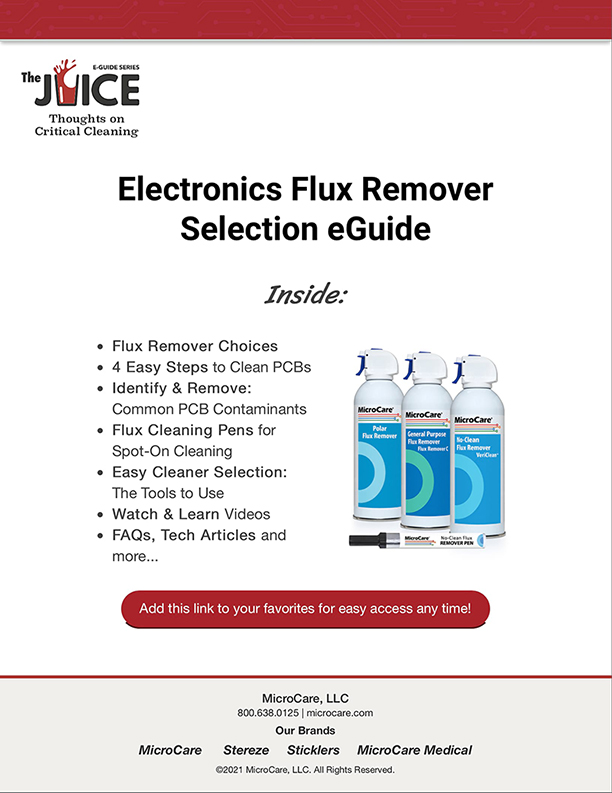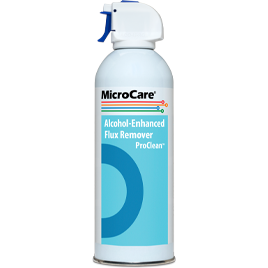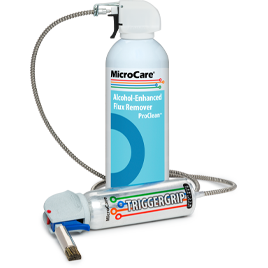Alcohol Enhanced Flux Remover - ProClean™
Product Information
ProClean Alcohol Enhanced Flux Remover delivers fast, easy PCB cleaning
Applications:
- Versatile cleaning — works great on R, RA, RMA, OA and SA fluxes and pastes
- Use on solder pastes, fluxes and fresh chip bonder
- Cleans through-hole and SMT boards, insulators, cables and connectors
Features:
- No residue/no rinsing
- Medium cleaning strength (test on soft plastics)
- Slow drying increases cleaning time when working with baked-on flux residue
- Kb Value: 45 (est.)
- Familiar alcohol odor
- Chemical Family: Alcohol blend
- Flammable (more economical than nonflammable versions)
- VOC content (g/L): 785
- RoHS, WEEE, REACH and EPA SNAP compliant
- NSN: 6850-01-361-0867
Use ProClean™ Alcohol Enhanced Flux Remove on a variety of flux types including rosin (R), Rosin Activated (RA) and RMA (Rosin Mildly Activated) fluxes, synthetic (SA) and water-based (OA) fluxes. ProClean™ is a blend of three high purity alcohols to clean better than ordinary IPA (Isopropyl Alcohol). It contains no water, which other companies use to dilute the solvent. Water reduces the cost but degrades the cleaning performance. ProClean is relatively slow-drying. That means operators have enough time to clean flux residue without wasting a lot of fluid. In addition, ProClean flux remover is mil-spec approved for many military products and electronics, including MIL-STD-2000. The aerosol cans are both TriggerGrip™ Cleaning Tool compatible and StatZAP™ ESD Eliminator Tool compatible.
Economical jumbo-sized aerosol cans deliver 30% more cleaner for only 15% more cost. ProClean Alcohol Enhanced Flux Remover is also available as presaturated wipes.
Product Details
Product Image |
Part Number | Package | Weight | Size | Technical Data Sheet | Safety Data Sheet |
|---|---|---|---|---|---|---|
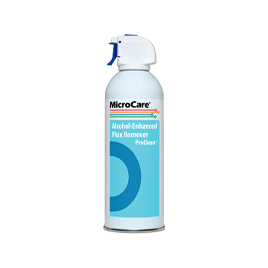
|
PRO ES1530 4050A MCC-PRO | Aerosol | 0.34 kg 0.75 lb. | 354 ml 12 oz. | ||
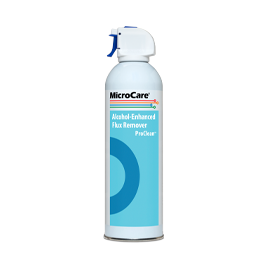
|
PRO16A MCC-PRO16A | Jumbo Aerosol | 0.54 kg 0.90 lb. | 650 ml 16 oz. | ||
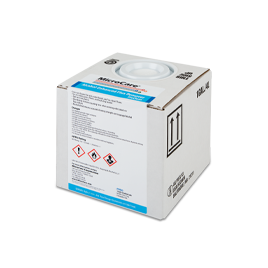
|
PROG MCC-PROG | Minicubitainer | 3 kg 6 lbs. | 3.8 L 1 Gallon | ||
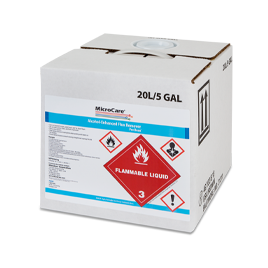
|
PROP MCC-PROP | Cubitainer | 15 kg 32 lbs. | 19 L 5 Gallons | ||
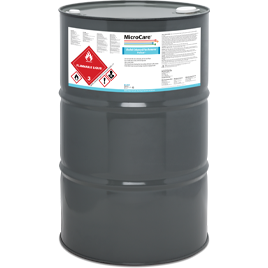
|
PROD MCC-PROD | Drum | 161 kg 355 lbs. | 208 L 55 Gallons |
| Part Number | MCC-PRO | MCC-PRO16A | MCC-PROG | MCC-PROP | MCC-PROD |
|---|---|---|---|---|---|
| Package | Aerosol | Jumbo Aerosol | Minicubitainer | Cubitainer | Drum |
| Weight | 0.34 kg 0.75 lb. | 0.54 kg 0.90 lb. | 3 kg 6 lbs. | 15 kg 32 lbs. | 161 kg 355 lbs. |
| Size | 354 ml 12 oz. | 650 ml 16 oz. | 3.8 L 1 Gallon | 19 L 5 Gallons | 208 L 55 Gallons |
| Technical Data Sheet | |||||
| Safety Data Sheet |
| Appearance | Clear, colorless fluid |
|---|---|
| Odor | Alcohol |
| PEL (ppm, 8-hr TWA) | 260 |
| Boiling Point | 77ºC / 173ºF |
| Chemical Family | Alcohol |
| Evaporation Rate | Slow |
| Cleaning Strength (Kb) | 45 |
| Active Ingredients | A blend of three water-free alcohols |
| Flashpoint | 17°C / 63°F |
| VOC Organic Content (g/L) | 785 |
| Ozone Impact | Zero |
| REACH & ELINCS Compliant | |
| RoHS & WEEE Compliant | |
| Safety Rating | Flammable |
| Specific Gravity | 0.79 |
| Vapor Pressure @ 20ºC | 5.2 |
- What Is a Kb Value? What Does It Tell Me About My Cleaning Fluid?
- What Does 'Hygroscopic' Mean? Why Is It Important?
- What's the Best Way to Clean PCBs at the Benchtop?
- How Do I Use the TriggerGrip™ System?
- What's Best for Cleaning RMA Fluxes and Pastes?
- Any NSN Numbers Assigned to MicroCare Cleaning Products?
- Is Dip-and-Brush Cleaning Good for Cleaning Circuit Boards?
- Why Does MicroCare Have So Many Different Benchtop Cleaning Choices?
- How Long Does a Can of MicroCare Flux Remover Solvent Last?
- Which Is the Mildest MicroCare Cleaner?
- Which Cleaner is Best at Removing Conformal Coatings?
- Which Cleaner is Best at Removing Silicones?
- Which Cleaner Works Best on OA Fluxes and Pastes?
- Which Flux Remover Is Best on Ceramic Hybrid Circuits?
- What's Best for Cleaning Under Low Clearance SMT Components?
- Which Cleaners Work Best in Ultrasonic Tanks or Dip Tanks?
- How Do I Dispose Empty Aerosol Cans and Pump Spray Bottles?
- Are Any MicroCare Products Nonflammable?
- Do Flammable Cleaners Create a Hazard on the Rework Bench?
- How Can I Ensure My People Are Handling Chemicals Properly?
- My People Are Complaining About Solvent Fumes. What Can I Do?
- What Are the NFPA Ratings for the MicroCare Cleaners?
- Do I Need Gloves When Working With MicroCare Cleaners?
- What's the Shelf Life of MicroCare™ Cleaners?
- Is Global Warming a Problem With Any MicroCare Products?
- Do MicroCare Aerosol Products Damage the Ozone Layer?
- Which Cleaners Can be Used in California?
- How Do I Measure PCB Cleaning Results?
- What Is a Toxicity Rating (PEL, TLV, AEL)? Which Solvent Is the Safest (Has the Least Toxicity)?
- Are There Any IPA Replacement Cleaners?
- What Cleaner Can I use for Removing Marking Inks, Sharpie Inks and Pen Ink?
- What Is the Liquid Quantity of Cleaner in a MicroCare Package?
- Do MicroCare Cleaners Meet the F-Gas Rules in Europe?
- Is MicroCare REACH Registered? Which Cleaners Can I Use in Europe?
- Which MicroCare Cleaners Can I Use in Australia?
- Which MicroCare Cleaners Can Be Used in Japan?
- MicroCare Lab Services for Critical Cleaning
- How-to: Using the TriggerGrip PCB Cleaning Tool
- Best Practices: Cleaning During PCB Rework and Repair
- Solder Paste and Flux Cleaning Results Revealed
- Cost-Cutter: Seven Ways to Save Money Cleaning PCBs
- How-to Connect and Disconnect the TriggerGrip Cleaning Tool
- Jumbo Sized Flux Removers Save Money
- Portable Flux Remover Pens are a Convenient Time Saver
- Cost Saving Products for Benchtop Cleaning
- Going Green with Vapor Degreasing
- MicroCare Leads the Way on Worker Safety and Regulatory Compliance
- MicroCare Critical Cleaning Experts
- The MicroCare Reliable Care Way
- MicroCare Partners in RENEX Hand Soldering Championship 2019
- Mike’s Radio Repair Demonstrates the TriggerGrip™ Cleaning System
- Case Study #15 — Cleaning Mixed Flux Residues from PCBs
- Azeotropes Explained
- Our Chemistries and Expertise Set Us Apart - APEX 2020 Interview
- Pre-Testing PCB Cleaning Saves on Manufacturing Costs
- How to Make the Best PCB Cleaning Choices
- Case Study 221 Buyer Beware
- Circuit Board Design & Cleaning Evolves to Support Down-Hole Logging Technologies
- Use Toxicity Ratings to Help Ensure Worker Safety
- The Meaning of Kb Value in PCB Cleaning
- TriggerGrip InfoGraphic
- Flux Remover Selection Guide
- The Importance of Drying in PCB Cleaning
- All Electronics Cleaning Wipes Are Not Created Equal
- Removing PCB Conformal Coatings
- Why Clean a No Clean Flux
- Safer Cleaning Choices Replace nPB in Aerosols for Worker Safety
- 4 Types of PCB Contamination and How to Remove Them
- An Early PCB Cleaning Plan Leads to Manufacturing Success
- Cleaning and Drying Before Conformal Coating: Why It’s Important
- MicroCare Offers IPA Alternative Cleaners
- Modern Electronics Require Updated Cleaning Methods
- Modern PCBA Cleaning: Methods to Improve Reliability
- Ensure Contact Cleaner Compatibility with Today’s Complex Electronics
- Stencil Wiping Fabric Improves Stencil Printer Through-Put
- Tips for Testing PCB Cleanliness
- Choosing the Right Flux Remover

